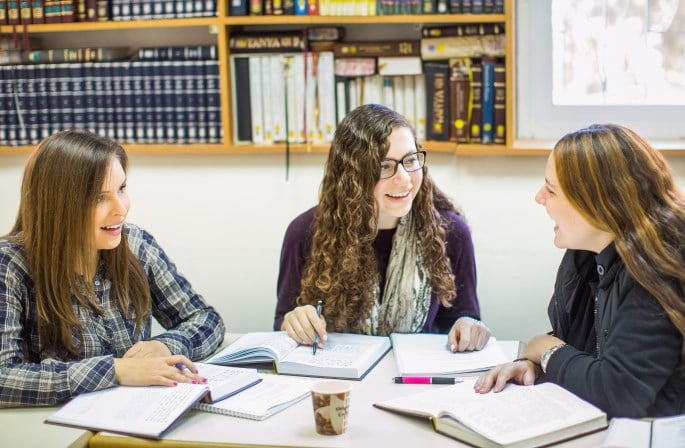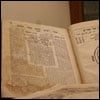Today, Friday, July 10, 2020, is super important. Not just because of what happened on this day (significant things happened on every day of the calendar), but because of what is happening.
Today (18 Tammuz on the Hebrew calendar), around the world, hundreds of thousands begin anew to study Maimonides’ Mishneh Torah — a digest that encompasses all the Torah’s laws and directives — as part of an annual study program that is starting its 40th cycle today.
Over the course of the next 11 months, we will continue to learn through the 14-volume compendium, absorbing a detailed and sweeping tour-de-force of the entirety of biblical and rabbinic law.
What Is “Daily Rambam”?
Rambam (also known as Maimonides) was a Talmudist, philosopher, doctor and rabbi born in Spain who flourished in Egypt in the 12th century.
Among his many works was the Yad Hachazakah, a 14-volume compendium of the totality of Jewish law, culled from Torah, Talmud, Midrash and the other teachings of the rabbis who preceded him.
In 1984, the Rebbe—Rabbi Menachem M. Schneerson, of righteous memory—instituted a daily study cycle, whereby the entire work (often simply referred to as “Rambam”) is completed on a regular basis.
How to Learn Daily Rambam:
- Those capable follow a three-chapter-per-day schedule, which completes the Mishneh Torah in slightly less than one year.
- For those unable to study three chapters every day, the Rebbe suggested a parallel track at a more modest pace of one chapter daily, which lasts nearly three years.
- For those who find even that too difficult, the Rebbe instituted yet a third track. Paralleling the three-chapter-per-day regimen by learning daily about the same commandments being studied there in detail, this one explores Maimonides’ significantly shorter Sefer Hamitzvot (“Book of Commandments”), concluding all 613 mitzvahs each year.
Resources to Aid Rambam Study
Hebrew texts, English translations, audio classes, video lectures and more are all available on the Chabad.org Daily Study page. Here is some of what you can find:
- Moznaim Publisher’s landmark translation of the entire Mishneh Torah in English by Rabbi Eli Touger is displayed neatly alongside Hebrew texts.
- Video classes on Mishneh Torah by the late Rabbi Yehoshua B. Gordon and on Sefer Hamitzvot by Rabbi Mendel Kaplan are both popular.
- Sefer Hamitzvot is available in versions geared for both kids and adults.
- You can receive Rambam and Sefer Hamitzvot via email.
- If you are an app person, the “Hayom” app has daily Rambam, along with other components of the daily study regimen and other handy information. You may also enjoy using the “Rabbi Gordon” app.
- And if you are a consumer of audio, especially podcasts, rest assured that we’ve got you covered.

The History of Learning Rambam
In the spring of 1984, the Rebbe—Rabbi Menachem Mendel Schneerson, of righteous memory—called for an innovative addition to the daily study schedule of every Jewish man, woman and child. He suggested that everyone study a portion of Mishneh Torah.
While many people had been turning to the 14-volume work to supplement their study of the Talmud or Jewish law, it was not being studied as a text on its own. Maimonides’ work was somewhat neglected, as the chief rabbi of Israel, the late Rabbi Ovadia Yosef, wrote at the time: “The Rebbe brought Rambam back from being a book for scholars to being a book for the masses to study.”
“The Rebbe brought Rambam back from being a book for scholars to being a book for the masses.”Part of the reason for this neglect was because the Mishneh Torah includes many laws that are not relevant today for daily life—laws that only applied during Temple times and will again be pertinent during the Messianic Era. So people turned, instead, to the works that focus on Jewish laws that are immediately applicable.
But it was for precisely this reason that the Rebbe recommended studying the Mishneh Torah: “It gathers all of Jewish law in a concise and clear fashion.” Every individual is commanded to study the entire Torah, a goal not within reach for most people. However, it is possible to study the whole Torah as compiled by Maimonides.
The Rebbe suggested that the Mishneh Torah should be studied straight through—from beginning to end—and that this be done according to an organized schedule.
What Learning Rambam Accomplishes
“One of the principal elements in the study of Rambam is the unification of Jewry,” the Rebbe was quoted in The New York Times as saying.
In a talk on April 28, 1984, the Rebbe explained that when everyone studies the same thing on the same day, their learning is united across continents. The Rebbe added that when different people study the same topic, they will come to discuss and debate it. This friendly and scholarly debate, the Rebbe said, will bring people closer to each other, contributing to unity among Jews.
Large numbers of Jewish people around the world immediately took it upon themselves to study the Mishneh Torah on a daily basis. Torah scholars and Chassidic masters issued their recommendation to join this new study cycle. Many Jewish dailies and weekly newspapers began printing the study schedule for the Mishneh Torah together with other existing daily study schedules.

When everyone studies the same thing on the same day, their learning is united across continents At the completion of every cycle, hundreds of celebrations take place in locations spanning the globe. Torah scholars from every segment of the Jewish community join these gatherings, delivering in-depth analyses on sections of Rambam.
“The people praising [Maimonides] were centuries removed from the life of Maimonides, who was born 851 years ago in Cordoba, Spain,” read The New York Times on March 6, 1986, following the celebration of the second completion of the cycle, at the Marriott Marquis Hotel in New York City. “Yet, after intensely studying his work this last year and applying his teachings, they gathered yesterday to celebrate the wisdom of the sage known to them as Rabbi Moshe ben Maimon, the Rambam.”
The article continued that “since Rabbi Schneerson instituted the program, studying Maimonides has become an integral part of many Jewish households.”
Now is the perfect time to get started. Join the daily Rambam program today!





